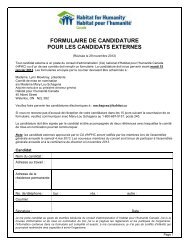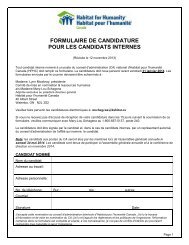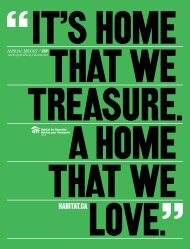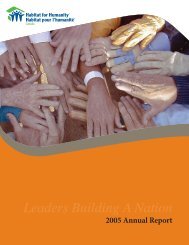PROGRESS IN HAITI
PROGRESS IN HAITI - Habitat for Humanity Canada
PROGRESS IN HAITI - Habitat for Humanity Canada
You also want an ePaper? Increase the reach of your titles
YUMPU automatically turns print PDFs into web optimized ePapers that Google loves.
Top: After the earthquake, the Charles family<br />
lived in an unhealthy makeshift structure.<br />
Bottom: Today, the Charles family lives in a<br />
new Habitat transitional shelter.<br />
THE CHARLES FAMILY:<br />
Thirsting for a house<br />
Rose Flore Charles and her three young children spent Jan.<br />
12, 2010, at the Léogâne home of Charles’ mother. They<br />
were not in their small apartment across town at 4:53 p.m.<br />
when the building collapsed during the earthquake, killing<br />
three of their neighbors. In that minute, nearly 90 percent<br />
of Léogâne was destroyed.<br />
For 16 straight nights, Charles and her children slept<br />
outside. Charles soon created a makeshift shelter near<br />
her mother’s damaged home. Made mostly of bedsheets,<br />
with metal gates propped together to provide a façade of<br />
strength, the structure has only a green coat-hanger wire to<br />
hold a scrap door tight.<br />
In Haiti’s rainy season—which brings even more malariacarrying<br />
mosquitoes—Charles’ children suffered. “Sleeping<br />
in the old shelter, the rain always got in,” Charles says. “We<br />
have to go to the health center and ask for help when their<br />
fevers get very bad.”<br />
As she speaks, a light rain leaves beads of water on her<br />
shoulders and on her 2-year-old daughter, Guallina Delva. But<br />
soon the Charles family will have a new place to take refuge:<br />
a Habitat transitional shelter.<br />
“I am thirsting for this house,” Charles says, smiling as<br />
she watches the wood-frame shelter being built.<br />
Charles’ family received one of the first 25 Habitat<br />
transitional shelters built in this community within Léogâne,<br />
about 18 miles west of Port-au-Prince and very near the<br />
epicenter of the January earthquake. By training and<br />
employing Haitians in communities hit hardest by the<br />
earthquake, Habitat is now constructing about 70 transitional<br />
shelters a week. Families help, too; Charles helped clear the<br />
ground for her shelter and hammered in nails.<br />
“This is not just a transitional<br />
shelter for me. It is a home.”
















